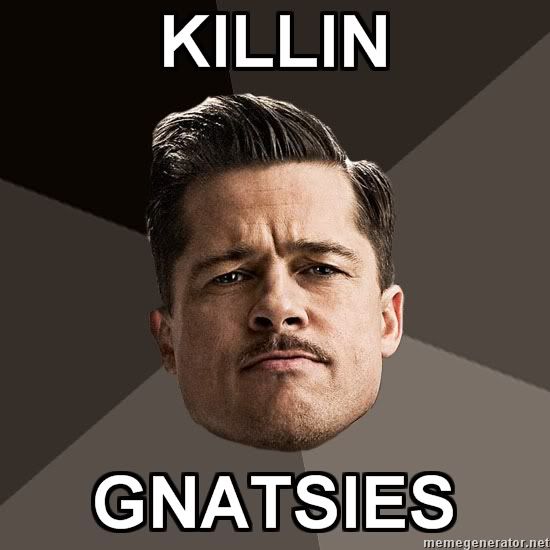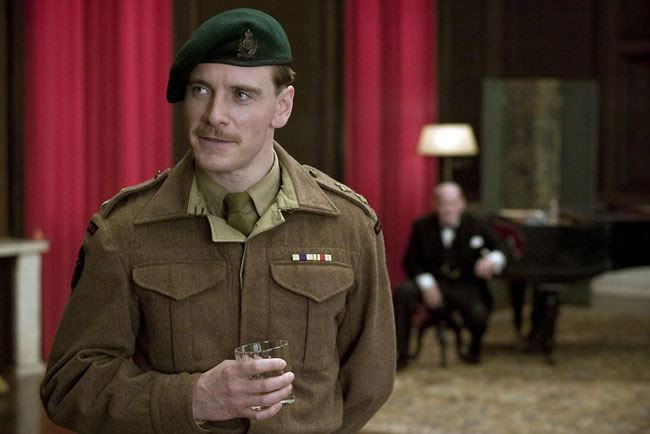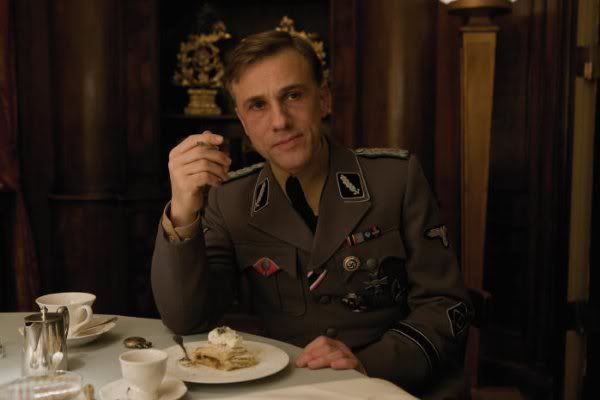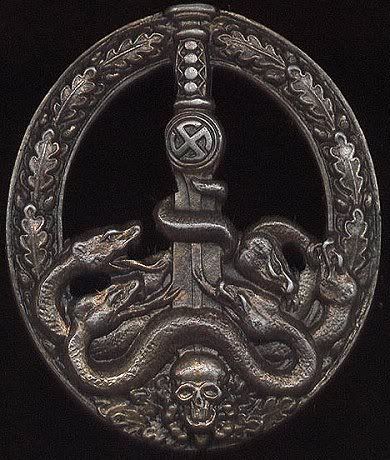Since I installed a Google-tracker on this blog, I have discovered that I've been getting a lot of hits for "inglourious basterds uniforms". This has made me realize that despite raving about the 'uniform porn' in the film, in my blog on the subject, I did not elaborate at all. The costume department for IB did a great job, and it plays a big part in the narrative, so I'd like to take this blog and look in more detail at the uniforms and medals displayed in the film.
Lieutenant Aldo Raine

Given his fondness for non-regulation items of uniform, it's hard to tell what Raine's story is. And I imagine that's the point. But one distinguishing feature is clear - he bears the patch of the 1st Special Service Force, known to their terrified German foes as "the Devil's Brigade". This was a handpicked outfit, specifically recruiting the hard bastards from across the American and Canadian Rockies. These were hardcore huntin', trappin', bear-wrasslin' dudes adept at surviving in the wild. Many were of Native American/Canadian heritage; the rest certainly liked to pretend they were.

Initially, the SSF was formed to defend against an expected Japanese invasion of Alaska. But when that never eventuated, they were sent to Italy (which Raine references), and proved brutally effective in the mountains there. They were amongst the first units to use camouflage facepaint; it became a signature of theirs, along with doing horrible things to German dead and wounded. Indeed, if the Basterds can be said to have had a real-world equivalent, the SSF would not be far off. So it stands to reason their chief should be from their ranks.
Another (well, one of the many) weird things about Raine is his low rank - he's only a 1st Lieutenant. The guy's clearly in his late 40's or early 50's; even in the slow promotion of a peacetime army, he should have been a Colonel by now - almost all Lieutenants are younger than 30. I suggest one of two scenarios. Firstly, he may have been promoted from the ranks - having worked his way up from Private, after about 30 years service. But this is unlikely. The second, and more plausible, theory is that he was recruited under dubious circumstances - from out of a jail cell, most like. But the Army needed him, and was willing to give him the absolute minimum - a Lieutenant's commission. He would never be promoted, however, and would probably have been kicked out at the end, pretty roughly. (If he hadn't wound up wiping out the whole Nazi leadership, of course!)
There's also the small matter of his lynching scar, but I wouldn't know where to begin with that one.
Lieutenant Archie Hicox

You know you're doing well when the REAL uniform nerds approve. The kit of IB's resident English warrior has met with nods from the British Army's Intelligence Corps - or at least, they seem pleased to note how 'Hollywood' has made more of an effort than usual.
Nonetheless, there are issues. The cap badge is right, but the beret is wrong; this distinctive piece of headgear didn't come into use for Int officers until long after the war. He should be wearing Intelligence insignia, not Royal Marine, as that would apparently supersede it. I think he was given the beret, red trident badge, and flash of a Royal Marine because it would be more recognizably "commando". Either that, or the Intel guys are trying to claim him for themselves.
His uniform ("battledress") is not standard issue, but this is because a gentleman would always have his privately tailored. So each was handmade and somewhat unique. His decorations may seem sparse but this is more due to British restraint. They are the Military Cross - won for a significant act of valor, most likely leading a commando raid - and the Africa Star, signifying service in the North African theater. So he's a veteran.
But this prompts questions about his rank, like Raine. With his formidable record, Hicox should be at least a Captain; some talented chaps like him had even made Colonel by his age. But despite its flaws, his uniform paints the correct image of an officer and gentleman - and commando.
SS-Standartenführer Hans Landa

The collar lapels tell us he's a Standartenführer; that is, an SS Colonel. His left sleeve bears the lozenge-badge and blank cuffband of the feared Sicherheitsdienst, or SD - the intelligence service of the SS. But there are two things that really jump out right away : the toxic shade of his jacket, and the fact he wears a brown shirt. This screams 'policeman'. A member of the Waffen- (military) or Allgemeine- (general) SS would wear a white shirt under either a field-grey jacket or the classic black one. But Nazi cops like Landa (members of the Polizei-SS) wore jackets in every offensive shade of green, from toxic shock to the more muted, greyish tone of Landa's one. So anyway, we know right away he's a policeman just from his shirt-and-jacket combo.
Working across his jacket (from our left-to-right), we very clearly see the Blood Order at his right breast. This was one of the most esteemed awards that the Reich had; it was only given to those who had been present at their giant fuckup in 1923, which they had mythologized as the "Beer Hall Putsch". So, originally, it was a very exclusive and closed club. But later, many senior Nazis (as was their petty wont) grew jealous of this and in 1938 the criteria were amended. Much to the disgust of the Nazi Old Guard, it could now be awarded to anyone with a minimum of 12 years' membership in the Party. Even this was waived if the candidate had been injured in the name of the Party before it had come to power in 1933. At any rate, you had to be a genuine Nazi. So Landa - who is not quite old enough to have 'been there' in '23 - has nonetheless clearly been a loyal and respected Party member for many years.
The ribbon at his buttonhole is the Iron Cross, 2nd Class. These were pretty much awarded for just showing up; it holds little esteem. His ribbon bar (above his left breast pocket) mirror his decorations; the Germans had an unusual practice of often wearing both the ribbon and the medal together on a uniform (other armies have just one or the other, depending on the occasion). The small swastika pin is an official Party member badge, of course; it was usually worn when the bearer didn't have much to show off, and wanted to make their collection look impressive.
The three medals across Landa's left breast pocket are his most interesting, and tell a story. On our left, the first is the Germanic Proficiency Badge. This was awarded to SS members who excelled either in athletics or political ideology. I can't see Landa being an Olympic hero (although given his numerous talents, it's possible) so it suggests he has an academic, as well as police, background. Edit : This award was only given to non-Germans; Landa would technically never have qualified for it.
The second is the War Merit Cross, with Swords. Anyone could get one of these; they were often specifically awarded so that the recipient could just have something to wear. To the experienced eye, it would suggest that the bearer hasn't seen a day of real combat, otherwise he'd have something more impressive. One SS General was awarded a WMC for the murder of 25,000 Riga Jews.
The non-combat role of Landa's, suggested by these medals, is utterly confirmed by the third one. I think it's worth looking at in detail, because it is so chilling:

This is the Anti-Partisan Badge, or as I call it, the War Criminal Identifier. It was awarded to those SS men who were sent against the various resistance ("partisan") groups which were fighting the Nazi tyranny. Naturally, these guys - like Landa - were monstrous murderers, and this gruesome badge means you can spot them right away. Seeing as they saw no combat, and hence earned no real decorations for valor, this is the closest they got at having an award for their butchery.
So Landa's uniform and medals are, obviously, a great complement to Waltz's amazing performance. Without his having to say a word, we know right away he's a hardcore Nazi cop with a lot of blood on his hands.
Gefreiter Frederich Zoller
This little jerk - he is a jerk, right? Nobody likes this guy? Okay. Anyway, this little jerk, as I noted in my first blog about IB, is wearing the uniform of the Grossdeutschland Division. (This formation is very popular with those weird guys who like to re-enact German forces in World War Two - they get to have the sexiness of an elite formation without the SS connotations, you see. They kind of miss the point that PRETENDING YOU ARE A NAZI SOLDIER IS WRONG AND STUPID EVEN IF YOU'RE JUST A BLOODY POSTMAN OR WHATEVER).
We know this is his outfit due to the monogrammed "GD" on his epaulettes, and his cuffband (with divisional title). The first time I watched IB I was busy trying to see his right sleeve cuff (yelling "turn around, you bastard!" in my mind) as well as paying attention to his conversation with Soshanna. Later on, at the Big Night, we get a real hardcore bit of uniform porn. Zoller is wearing a special uniform that was unique to his division. It was designed to ultimately replace their standard ones, but only a few hundred were developed, as conservative reaction stopped it from being adopted. It really stands out in contrast to other German uniforms, and is something of a oddity. It's like the militaria version of that weird Emil Jannings cameo in the same scene.
It should be noted that Grossdeutschland never served in Italy, and certainly never fought Americans - it spent the whole war on the Eastern Front. So unless Zoller served in another unit in Italy, and was later transferred to Grossdeutschland, then that's a mistake. Mind you this scenario is possible, so perhaps we should go for benefit-of-the-doubt? His service in this elite formation kind of backs up his whole war hero thing.
He really should have more medals - a Knight's Cross, the highest award they could give him, would make perfect sense. It does seem a bit noticeable by its absence.
EDIT : I've since learned he does have the Knight's Cross in one scene but none of the others - which is extremely odd! For further reading I direct your attention to the Clothes on Film review of IB, (here) and the FlickFilosopher (here). The latter has a hearty debate about the role of uniforms in the movie in the comments.
I should also note all the hits I've been getting for "lezbein", "pr0n", and variations thereof; but don't worry, I won't start doing blogs for illiterate perverts; although a rebranding may be in order...
5 comments:
GD was a bit unique in that it drew recruits from all over greater germany - while other divisons drew from various wehrkriese. He could well have been transferred into GD due to his exploits.
Few if any would start their career in GD - hence it's almost unique statis as "elite" within the Heer
Landa's tunic is actually field grey. The SS didn't have green uniforms, although greenish grey ones could be encountered, mostly among the Waffen-SS. Brown shirts were worn by all SS members, with white ones reserved for formal occasions. He shouldn't be wearing the blank cuff band, by the way, since he wasn't attached to an SD district, or an Einsatzgruppe, but to the Commander of the Security Police and the SD in France.
The ribbon in his buttonhole is actually the War Merit Cross, 2nd class. And no, the Iron Cross was not awarded just for showing up.
The party badge he is wearing is in fact the Golden Party Badge, one of the highest political decorations (supposed to be worn in the middle of the left breast pocket, incidentally).
Although it's hard to tell from the picture, he seems to be wearing the War Merit Cross 1st class w/o swords, which makes more sense, since the version with swords was awarded to those operating in a combat zone, and also to members of the Einsatzgruppen. According to Landa, he was transferred to France from Austria in 1941, so he is unlikely to have served with an EG.
The Anti-Partisan Badge is an unlikely decoration for Landa, since those were awarded for at least 20 days of fighting guerrillas. To my knowledge, major anti-partisan operations never took place in the West.
Thanks Walter, the more clarification this blog can get, the better.
Thanks for the post, clarifies a bunch! In the film Landa mentions coming to France from Austria and Christopher Waltz is Austrian so I think Tarantino intended that to be the character's homeland. Not sure if this would count as making him open to the Germanic Proficiency Badge, (awarded before the Anschluss? or maybe another way to inflate his medal count like you mention in other parts? No idea)
I was wondering though about the badge that Hicox wears on his left shoulder and that's what led me to this post. At first I thought it looked like a pagoda on a red background suggesting fighting in East Asia (although conceptually odd for the 1940's) but looking at it closer I can make out that it depicts a mitrailleuse with some other symbols above and below it. Any insight?
Thank you for your friendly post Anon! I believe Hicox's badge is the crossed red trident, wings and rifles of the Combined Ops teams, of which - as an RM commando - he would have been a part. Take at look at this link; I believe out badge is #10.
http://www.combinedops.com/INSIGNIA%20SPECIMENS.htm
Post a Comment